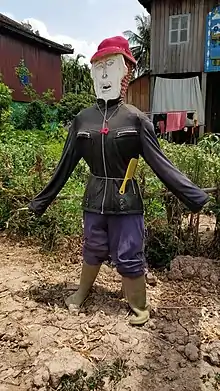Ting mong
Ting mong (Khmer: ទីងមោង) is a decoy or mannequin popular in Khmer folklore, traditionally with a head and no body, but more recently in the shape of a human, similar in its shape to the scarecrow, but different in its function as its purpose is not to scare crows but to fight away evil spirits and plagues.

Origin: the temple guardians
According the Khmer ethnologist Ang Choulean, the Khmer scarecrow can be traced back to the guardian deities in the Angkorian temples. Those with a scary face and no body, can be traced back to the figure of Rahu, while others recall giants and demons of Khmer mythology.[1]
Design: from warrior gods to humanoids
Ting mong have varying designs in the different provinces of Cambodia. They are often made of an old pot of broken clay painted with charcoal to make a scary face. They are hung on the outer fence of private houses, especially near the entrance.
In the Province of Siemreap, ting mong are often weapon-bearing scarecrows.[2]
Since the 1990s, the design of the ting mong has evolved as villagers decorated the entrance of the village or their houses with humanoid scarecrows using second-hand clothes which were cheaper and more accessible in bulk than in the past. While the original idea was to scare the ghosts away, ghost scarers now tend to look more like human beings who emit a certain sense of humor.[3]
In the present day, superstitious farmers erect ting tong as floral-shirted scarecrows with a plastic pot for a head and armed with a stick.[4]
Function: spirits, laughter, and plagues
The original function of the ting mong was to chase away the evil spirits.
After the fall of the brutal Khmer Rouge regime in 1979. according to the recollections of older Cambodians, people made effigies of Khmer Rouge soldiers, trapping their spirits inside scarecrows that were then burned in mass bonfires. In alternative tellings of this story, a disease spread throughout the provinces that year, associated with the dead cadres, and scarecrows were erected to banish it.[5]
The rocambolesque apparel with which they have been geared with since the 1990s has suggested a more humoristic function. Since 2020, ting mong have gained in popularity as they helped to soothe the fear linked to the pandemic of coronavirus.[6]
See also
References
- Choulean, Ang (2022). "ទីងមោង". Khmer Renaissance – Yosothor Dictionnary (in Khmer). Archived from the original on January 26, 2022. Retrieved January 26, 2022.
- Bernak, Fred (2018-09-28). LIFE The World's Most Haunted Places: Creepy, Ghostly, and Notorious Spots. Time Home Entertainment. ISBN 978-1-5478-4556-9.
- Peang-Meth, Abdulgaffar (1992). "The United Nations Peace Plan, the Cambodian Conflict, and the Future of Cambodia". Contemporary Southeast Asia. 14 (1): 33–46. doi:10.1355/CS14-1C. ISSN 0129-797X. JSTOR 25798137. Archived from the original on 2022-01-26. Retrieved 2022-01-26.
- "Cambodian farmers deploy scarecrows to ward off virus – Khmer Times". 2020-10-13. Retrieved 2022-01-26.
- Sacker, Jade (12 June 2020). "In Cambodia, a Spiritual Army Battles an Earthly Pandemic". Foreign Policy. Archived from the original on 2022-01-26. Retrieved 2022-01-26.
- "Cambodian villagers trust magic scarecrows to ward off coronavirus". Reuters. 2020-11-26. Archived from the original on 2022-01-26. Retrieved 2022-01-26.
External links
- Choulean, Ang (2022). "ទីងមោង". Khmer Renaissance – Yosothor Dictionnary (in Khmer). Retrieved January 26, 2022.